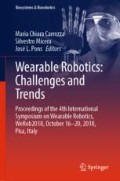Abstract
This work presents an intuitive graphic interface to make its users aware of potentially risky body configurations while being exposed to external loads. Employing an algorithm we proposed in a recent work, we estimate the human joint torque overloading caused by an external force. This information is used as an input for the graphical interface to provide the user with an intuitive feedback about the strain on each joint. Hence, the users can be aware of the loading states, react to them accordingly, and minimise the risk of injuries or chronic pain. This graphical interface can help the users learn and achieve more ergonomic configurations during industrial job duties.
Access this chapter
Tax calculation will be finalised at checkout
Purchases are for personal use only
Notes
- 1.
The overloading joint torque refers to the torque induced into the human joint by an external load.
References
Bevan, S.: Fit for work? Musculoskeletal disorders in the European workforce. The Work Foundation (2009)
Kumar, S.: Theories of musculoskeletal injury causation. Ergonomics 44(1), 17–47 (2001)
Van Den Bogert, A.J.: Analysis and simulation of mechanical loads on the human musculoskeletal system: a methodological overview. Exerc. Sport. Sci. Rev. 22, 23–23 (1994)
Ayusawa, K.: Identifiability and identification of inertial parameters using the underactuated base-link dynamics for legged multibody systems. Int. J. Robot. Res. 33(3), 446–468 (2013)
Azuma, R.: Recent advances in augmented reality. IEEE Comput. Graph. Appl. 21(6), 34–47 (2001)
Kim, W.: A real-time and reduced-complexity approach to the detection and monitoring of static joint overloading in humans. In: International Conference on Rehabilitation Robotics (ICORR), pp. 828–834. IEEE (2017)
Author information
Authors and Affiliations
Corresponding author
Editor information
Editors and Affiliations
Rights and permissions
Copyright information
© 2019 Springer Nature Switzerland AG
About this paper
Cite this paper
Lorenzini, M., Kim, W., De Momi, E., Ajoudani, A. (2019). A Real-time Graphic Interface for the Monitoring of the Human Joint Overloadings with Application to Assistive Exoskeletons. In: Carrozza, M., Micera, S., Pons, J. (eds) Wearable Robotics: Challenges and Trends. WeRob 2018. Biosystems & Biorobotics, vol 22. Springer, Cham. https://doi.org/10.1007/978-3-030-01887-0_54
Download citation
DOI: https://doi.org/10.1007/978-3-030-01887-0_54
Published:
Publisher Name: Springer, Cham
Print ISBN: 978-3-030-01886-3
Online ISBN: 978-3-030-01887-0
eBook Packages: EngineeringEngineering (R0)

